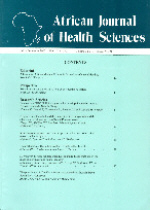
|
African Journal of Health Sciences
The Kenya Medical Research Institute (KEMRI)
ISSN: 1022-9272
Vol. 13, Num. 1-2, 2006, pp. i
|
African Journal of Health Sciences, Vol. 13, No. 1-2, Jan-June, 2006, pp.
i
EDITORIAL
Accessibility and affordability of malaria intervention, treatment and prevention
in Africa
Davy K. Koech, PhD
Editor-in-Chief
Code Number: jh06001
The management of malaria has become a problem of increasing importance in the world, and particularly in Africa. There are three main facets available for the management and control of malaria, namely, intervention measures, treatment of the disease, and prevention against the disease. In Africa, all measures taken against malaria must be affordable and accessible. Due to low economic capacity of the African in the poor socio-economic communities, there is need to carry out research to determine the most appropriate measures in interventions, treatment, and prevention strategies. There are many institutions in Africa, which are investigating how malaria can be controlled along these lines. For example, at the Kenya Medical Research Institute (KEMRI), there are centres of excellence, which provide leadership in the fight against malaria. The Centre for Vector Biology and Control Research takes responsibility for all aspects of vector control research and coordinates research nationally and regionally, and it promotes the use of impregnated bed nets and investigates how this intervention measure can be made affordable and accessible in an efficient manner. There is also another centre of excellence, the Centre for Geographic Medicine Research that takes the lead in clinical treatment of malaria with particular reference to paediatric treatment regimes. The currently proposed Antimalarial Drug Combination Therapy [1, 2 ] appears very attractive and requires exhaustive evaluation. It involves the combination of artemisinin and its derivatives with some existing antimalarial drugs, and these include: Artesunateamodiaquine, artemether-lumefantrine (Coartem), piperaquine-dihydroartemisinintrimetoprim (Artecom), and Pyronaridine-artesunate. There are also non-artemisinin-based combinations such as: Atovaquone-proguanil (Malarone), Mefloquine-sulfadoxinepyrimethamine (Fansimet), and Quinine-Doxycycline. The question is: do these drug combinations meet the basic criteria of accessibility and affordability for the resourcecommunities in Africa? No. Then other alternatives must be sought. The Centre for Clinical Research, another centre of excellence at KEMRI, is looking for such alternatives. The Centre is the flag bearer of clinical research in the Institute. It also hosts the Africa Regional Office of the Drugs for Neglected Diseases Initiative (DNDi). The Centre presented a report at a WHO meeting on a pilot clinical evaluation of a plant-derived traditional antimalarial medicine which appeared promising. This report demonstrated that those traditional remedies that possess sufficient ethnomedical evidence can be explored and developed through a fast track process. Some of them have been reported [3] to be useful as prophylactic or preventive agents.
There is, no doubt, an urgent need for newer antimalarial medicines for use
in the resourcepoor communities in Africa. KEMRI is striving to achieve these
goals and it is desirable to link up with other institutions with similar objectives.
- WHO. The Use of Artemisinin & its derivatives and antimalarial drugs.Report of a joint CTD/DMP/TDR Informal Consultation. Geneva 1998.
- WHO. Antimalarial Drug Combination Therapy. Report of a WHO Technical Consultation. WHO. Geneva 2001
- Rukunga GM and Simonds AJ. The potential of plants as a source of antimalarial agents. A review. Africa Herbal Antimalarial Meeting. World Agroforestry Centre. Nairobi 2006.
Copyright 2006 - African Forum for Health Sciences
|
